| Pages:
1
2
3
4
5
6
..
10 |
aga
Forum Drunkard
    
Posts: 7030
Registered: 25-3-2014
Member Is Offline
|
|
I got a couple of loaves cooking (as in normal cooking) at this moment.
Basic bread recipe this time with the salt swapped for calcium chloride and about 3x sugar than normal.
Tried this yesterday, but way overdid the CaCl2 which stopped the yeast working, so the dough did not rise.
I think the difficulty in making these materials is not the carbonisation, but the retention of any kind of durable form in the process.
[Edited on 5-11-2016 by aga]
|
|
|
violet sin
International Hazard
    
Posts: 1475
Registered: 2-9-2012
Location: Daydreaming of uraninite...
Member Is Offline
Mood: Good
|
|
Used an old hacksaw blade to regularize it's shape, then part it out.
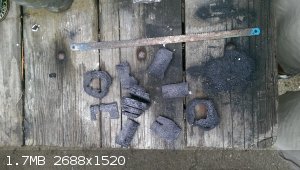 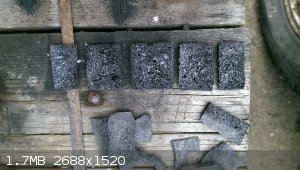
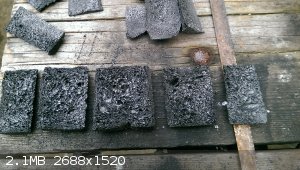 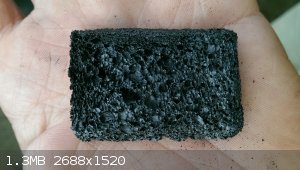
Looks nice!!! Makes me wish I could sputter metals onto the surface. The outside chunks are quite strong, resist breaking and the lot still sounds
clinky when jarred together.
Wondering about second and third roasts now. Gauzing up the outside of a block with cotton balls/matting streched super thin.
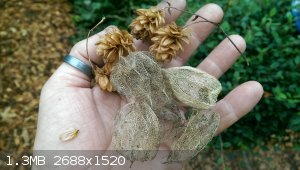
what about ground cherry and hops flowers? Ehh? Could get fun quickly here folk.
Was at the store grabbing food stuffs, found my self wondering about charred cheerio's with metal oxides for cheap fluidized bed catalyst supports?
[Edited on 5-11-2016 by violet sin]
|
|
|
aga
Forum Drunkard
    
Posts: 7030
Registered: 25-3-2014
Member Is Offline
|
|
Superb ! You made my day !
Natural materials are definitely worth looking at, and trying out.
Edit:
I wonder if lightly clamping the bread between some metal plates during carbonisation would be helpful ?
It should reduce the pore size and get more material into the space = higher surface area, also help retain a shape (a slab in this case).
Clamping pressure will definitely be important - too much and it'll squish all the air/CO2 out, too little and it'll go all warpy and
bendy.
Loaf #1's gonna get clamped and toasted.
[Edited on 5-11-2016 by aga]
|
|
|
unionised
International Hazard
    
Posts: 5102
Registered: 1-11-2003
Location: UK
Member Is Offline
Mood: No Mood
|
|
Quote: Originally posted by aga  |
Er, dunno, not tried that - yet.
1 sec.
Edit:
Woot woot !
It gets all jiggy like an electric arc furnace and really annoys the wife !
It also makes a bzzzzt-bzzzzt noise, exactly like an electric arc.
I noticed some bits of Al foil still stuck to it, so broke off a smaller piece with no foil, and tried again.
It did the same thing.
[Edited on 5-11-2016 by aga] |
Proper science!
|
|
|
unionised
International Hazard
    
Posts: 5102
Registered: 1-11-2003
Location: UK
Member Is Offline
Mood: No Mood
|
|
Quote: Originally posted by wg48  | [
How much AlPO4 does citric acid disssolve?
Wiki says AlPO4 melts at 1800C so a solution of it may make a great refectory binder or a flux.
|
It dissolves enough to make the solution quite viscous.
AlPO4 has a high MP, but it has some phase transitions (they look rather like those of SiO2- the structures are similar).
Those mess it up a bit as a refractory.
If you want to try it, I'd suggest trying oxalic acid instead. There's less carbon to burn off, and more oxygen in the molecule so you should get less
charcoal.
If you don't care about the colour, conductivity and IR absorbance the citrate works fine.
I might have another go sometime, but use soaked cotton thread + see what I get.
|
|
|
aga
Forum Drunkard
    
Posts: 7030
Registered: 25-3-2014
Member Is Offline
|
|
The Science comes later.
Right now it's all just Fun and making stuff to do some Science on.
Hard to science-up an over-toasted slice of bread by science alone.
For the Deep Science thinkers, please suggest some tests/experiments on these materials that will prod all this further than just Advanced Toast
Burning !
I already did the I.N. number protocol for 'activated carbon' testing.
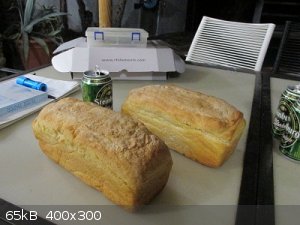
|
|
|
Morgan
International Hazard
    
Posts: 1660
Registered: 28-12-2010
Member Is Offline
Mood: No Mood
|
|
Melba toast seems structurally sound, so maybe Melba toast would be something to try. If nothing else it might be a convenient path to thin carbon
foam.
"Because Melba toast was such a hard toast, it was often given to infants as teething biscuits."
http://www.nationaldaycalendar.com/national-melba-toast-day-...
|
|
|
TheAlchemistPirate
Hazard to Others
  
Posts: 151
Registered: 25-3-2014
Location: The point of no return
Member Is Offline
Mood: Enigmatic
|
|
Success! I have managed to create smooth, electrically conductive carbon foam using my own homemade dough! This time I allowed the bread to cook
longer as well.
A particular piece of bread produced a region of a very "graphite-like" substance, which had a resistance of a few hundred Ohms when the test leads
were 2 cm apart! (in some regions)
Resistance of one part of the chunk- http://imgur.com/1pcSKy1 (89,200 Ohms)
Resistance of another part- http://imgur.com/oEzDIdo (3,350 Ohms)
(I couldn't find the hundred Ohm regions again)
I will soon attempt to coat this material in copper metal. Also, the more conductive parts of the chunk did arc amazingly in a microwave oven.
[Edited on 5-11-2016 by TheAlchemistPirate]
"Is this even science anymore?!"
|
|
|
Jstuyfzand
Hazard to Others
  
Posts: 166
Registered: 16-1-2016
Location: Netherlands
Member Is Offline
Mood: Learning, Sorta.
|
|
I wonder if the time you let it cook and the conductivity are related...
|
|
|
aga
Forum Drunkard
    
Posts: 7030
Registered: 25-3-2014
Member Is Offline
|
|
Nice one !
Resistance testing is a good idea.
Tried it on my remaining lump and got 30~40 ohms over 20mm !
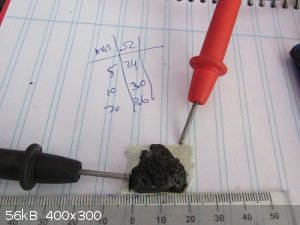
Making an electrical connection is a bit hit-and-miss. Might be better to rig up some kind of wire pads for the probes, like q-tip sized balls of wire
wool.
Didn't realise it was quite hard to cut with a hacksaw - must have a been a lot of work there violet sin.
|
|
|
violet sin
International Hazard
    
Posts: 1475
Registered: 2-9-2012
Location: Daydreaming of uraninite...
Member Is Offline
Mood: Good
|
|
Super quick attempt to plate Ni across a chunk this afternoon failed. Power source AC plug was 12v 2A rated wall wart type, too high V. Couldnt find
Ni rod so used MMO counter electrode which worked fine. Multmeter tests for resistance were not measured as everything was basicaly nonconductive
before hand. Maybe need a hotter temp for longer, SS cup shields it too much? anyhow the Ni plated out as a redish sponge that barely crawled across
the bit, not adhering at all. Work on the next powersupply was interrupted mid step and needed soldering, meaning more set up time instead of making
a couple rough conections.
Regardless I set drained electroplating bits in the bottom of the next run. With random trimmings and the next chunk of bread(sourdough). Which was
also doused with some plating solution prior to sealing. Hopefully the Ni sulfamate will decompose on the framework increasing initial conductivity.
And the second run on last product may harden it more/increase conductivity. Some was doped with plating sol. and some was nontreated. So I should
have some tests to do time permitting. Nap time flys by, hard to get much done project wise before obligations call.
Several different samples of ground cherry flower skeletons are cooking also. Use of three short SS tubes was employed. Samples were either chopped
up and mixed, flattened then wrapped around a cylinder, wadded in a cone inside a cylinder or a few whole. Fire doesnt seem as hot tonight, so doing
it for longer. Kinda roasted the front room last night temp wise.
Mine wasnt particularly hard to cut with a hacksaw. Far more resistant than I would have thought, but still nothing physically difficult.
|
|
|
wg48
National Hazard
   
Posts: 821
Registered: 21-11-2015
Member Is Offline
Mood: No Mood
|
|
If the bread is very dry before carbonization does it still distort durring carbonization.
If your trying an initial electroplate you can make a crude Hull cell by angling the counter electrode so that the distance between it and the
substrate varies. That will vary the current density across the substate. Low conductivity of the substrate may have a similar effect. It may give an
indication of the correct current density to get the type of plating you require.
[Edited on 6-11-2016 by wg48]
|
|
|
wg48
National Hazard
   
Posts: 821
Registered: 21-11-2015
Member Is Offline
Mood: No Mood
|
|
Quote: Originally posted by unionised  |
It dissolves enough to make the solution quite viscous.
AlPO4 has a high MP, but it has some phase transitions (they look rather like those of SiO2- the structures are similar).
Those mess it up a bit as a refractory.
If you want to try it, I'd suggest trying oxalic acid instead. There's less carbon to burn off, and more oxygen in the molecule so you should get less
charcoal.
If you don't care about the colour, conductivity and IR absorbance the citrate works fine.
|
Apparently aluminium acid phosphates solutions are used as a ceramic binder. In particular with alumina ceramics in which it slowly chemicaly combins
with the alumina to form various phosphates. According to the link below the service temperature is only about 1000C
https://books.google.co.uk/books?id=GPyI96S48PAC&pg=PA12...
That may be how castable ceramics are formulated as oposed to using cement like hydration reactions that reverse at temperature.
|
|
|
Morgan
International Hazard
    
Posts: 1660
Registered: 28-12-2010
Member Is Offline
Mood: No Mood
|
|
I was thinking bolete mushrooms would be a hopeful try at carbonizing because of the many dense little pores but here they are toying with another
kind of fungus for electrodes.
https://commons.wikimedia.org/wiki/File:Tyromyces_fissilis_9...
http://mycoweb-sae.narod.ru/fungi/Js/Photo_show.html?&.....
"Carbon fibers derived from a sustainable source, a type of wild mushroom, and modified with nanoparticles have been shown to outperform conventional
graphite electrodes for lithium-ion batteries."
http://phys.org/news/2016-04-cook-battery-anodes-wild-mushro...
|
|
|
BOD513
Harmless

Posts: 10
Registered: 15-2-2016
Member Is Offline
Mood: No Mood
|
|
Soaking the bread in a ferric chloride solution before carbonizing it would probably increase the degree of graphitization, and you could then just
wash the iron ii,iii oxide off with hcl. This might make electroplating it easier.
|
|
|
violet sin
International Hazard
    
Posts: 1475
Registered: 2-9-2012
Location: Daydreaming of uraninite...
Member Is Offline
Mood: Good
|
|
Morgan,.. I know this guy... Aka me, who has been slaying the boletes  had the
same though a few days ago, but didn't post it cause figured it was getting ahead of my self. had the
same though a few days ago, but didn't post it cause figured it was getting ahead of my self.

|
|
|
aga
Forum Drunkard
    
Posts: 7030
Registered: 25-3-2014
Member Is Offline
|
|
Quote: Originally posted by Morgan  | | I was thinking bolete mushrooms would be a hopeful try at carbonizing because of the many dense little pores ... |
Tinfoil, fire, find out, tell us the results.
Is there any human alive who has lost the ability to make Fire ?
|
|
|
unionised
International Hazard
    
Posts: 5102
Registered: 1-11-2003
Location: UK
Member Is Offline
Mood: No Mood
|
|
I suspect I know some who would have to Google it.
I wonder what other food would work.
Does fried bread work?
Incidentally, on a vaguely related note, you can mix soft wax into fire cement and end up with an "emulsion" of sorts, from which you can burn out the
wax to leave a porous refractory.
|
|
|
Morgan
International Hazard
    
Posts: 1660
Registered: 28-12-2010
Member Is Offline
Mood: No Mood
|
|
I've some meter long quartz tubes with a mere 19 mm inside diameter/25 mm o.d. that I don't mind trashing but I'm trying to figure out what to stuff
them with because I can blowtorch the quartz glowing red hot without damage. It's just deciding how to form some material so that it doesn't stick to
the sides. Maybe something a few millimeters smaller in diameter, perhaps plug the ends with foil and I don't have any inert gases. Also if I cored
the material some sort of carbon foam tube could be made, again if I can get around the potential sticking or bonding to the coring rod if used and
the quartz tube. The coring rod would probably prevent deformation to some extent. One other thought comes to mind using this technique, just some
free association going on. Probably would need some fine tuning to have a chance.
https://www.youtube.com/watch?v=g4ph-h7l_aM
Aga, I know how you feel about doing experiments. I'm the same way really, if you want to know something the best way is to try it, and it's not only
that but you discover lots of other things in the process, and better ways of doing things. And when the mood hits, there's nothing more fun than
experimenting.
Violet sin, I'm glad someone else saw a potential in boletes, because I felt I was going out on a limb posting the thought. Some kinds of bracket
fungi you find might be something to try. Another odd material maybe just to toy with ... http://www.ecovativedesign.com/myco-foam
Lastly, if I just wanted to make a light carbon tube maybe something along these lines would do if carbonized and starting with a fluffier pasta
material.
http://hungry-4-more.com/wp-content/uploads/2009/06/dscn0510...
http://www.pastagarofalo.it/cms/uploads/product/ziti_linghi_...
[Edited on 7-11-2016 by Morgan]
|
|
|
j_sum1
Administrator
       
Posts: 6219
Registered: 4-10-2014
Location: Unmoved
Member Is Offline
Mood: Organised
|
|
Oh to have some metre long quartz tubes. Nice.
If the concern is material sticking to the sides, I think that is easily remedied. I would wrap a slug of material that I was charring with paper.
When done you can push the whole thing out and little should remain. Nothing that cannot be cleaned anyway.
As for an inert gas, I think CO2 is inert enough in this case. perhaps drop some dry ice in when you charge the tube and allow the sublimation to
displace any air.
A nice advantage of the setup you propose is that you can potentially prepare several different samples at the same time.
|
|
|
Morgan
International Hazard
    
Posts: 1660
Registered: 28-12-2010
Member Is Offline
Mood: No Mood
|
|
Yes, maybe something like parchment paper would do the trick to prevent sticking to the sides. Good suggestion.
|
|
|
j_sum1
Administrator
       
Posts: 6219
Registered: 4-10-2014
Location: Unmoved
Member Is Offline
Mood: Organised
|
|
I am going to retract something I said before. I indicated that I would write something up for the wiki on this process. However this topic is
exploding a bit. There are at least four different lines of interest: each seeking to optimise for different things and each with its own potential
line of inquiry. I think it would be premature for me to write anything at this stage. We have
refractory applications -- in which case the task is to optimise structural integrity and strength, minimise deformation or
include a shaping process, and minimise thermal conductivity.
a source of activated charcoal -- maximising surface area and hence absorbance is the goal here.
substrate for catalysis -- suggestions have been floated on how to incorporate a catalyst into the structure while maximising surface area.
use as electrodes -- here, electrical conductivity is the goal with some structural requirements and requirements for electrical connections as
well as durability in service.
On top of this are proposed a few different schemes for making/obtaining bread for the task, suggestions of alternate starting materials (mushrooms)
and a couple of different schemes and apparatus for pyrolising.
This looks to be a very fruitful area of study. Kind of exciting really. And new ideas are emerging faster than they can be tested. You gotta love
the collaborative amateur scientific approach!
|
|
|
aga
Forum Drunkard
    
Posts: 7030
Registered: 25-3-2014
Member Is Offline
|
|
Catalytic reaction converting CO2 directly to ethanol ?
Now we're talking business.
https://www.ornl.gov/news/nano-spike-catalysts-convert-carbo...
|
|
|
Morgan
International Hazard
    
Posts: 1660
Registered: 28-12-2010
Member Is Offline
Mood: No Mood
|
|
It sure would be nice to have a kiln to do some of these experiments. Here's some metal containers I bought in the past that might be suitable for
carbon foam but probably there're lots of things you could get by with using. Here's some I thought about.
These are ~4.5 inch diameter threaded steel jars from a government agency in Colorado that were used for training of collecting radioactive materials.
There's a reed valve I was thinking about installing that didn't come with them but they also have a 4-way steel insert that divides the jar. Maybe I
could use the insert to separate some samples.
http://www.pulse-jets.com/phpbb3/download/file.php?id=8066
I drilled a hole in the lid of one of them.
http://www.pulse-jets.com/phpbb3/download/file.php?id=8068
Then there's these tri clover pint-sized jars made of 316 steel. I'm not sure what the larger filter thing is but I bought it on eBay because it
looked like something I could use.
http://www.pulse-jets.com/phpbb3/download/file.php?id=7946
The jars have a Teflon gasket and you can instead of using the metal cap clamp two jars together. I just wonder how much pressure they would hold
safely?
http://www.pulse-jets.com/phpbb3/download/file.php?id=14221&...
Some other perspectives if anyone has any other good uses for these things.
http://www.pulse-jets.com/phpbb3/download/file.php?id=14209&...
One with a ferrule fitting instead of a cap.
http://www.pulse-jets.com/phpbb3/download/file.php?id=2139
This long middle piece is some 3 inch pipe I could cap and clamp at both ends, maybe good for some French bread carbon foam shapes.
http://www.pulse-jets.com/phpbb3/download/file.php?id=9199
Some steel water bottles inverted and stuffed inside the heavy steel tri clover jars.
http://www.pulse-jets.com/phpbb3/download/file.php?id=14210&...
Here's a rough cut high temperature gray gasket meterial I cut out and a piece of capillary copper tubing that was an attempt to seal or press-fit
into the half grove of the lid and jar where they meet. I didn't cut the tubing quite long enough as you can see but it was just an idea and I have
lots of tubing. The Teflon gasket is nice but not good for high heat.
http://www.pulse-jets.com/phpbb3/download/file.php?id=2150
There's these Vollrath jars I found that are for kitchen use, maybe to hold cream or sugar. There's one with a lid on the bottom right in this photo.
http://www.pulse-jets.com/phpbb3/download/file.php?id=5258
http://www.pulse-jets.com/phpbb3/download/file.php?id=2035
I was thinking maybe even a large coffee can with the top cut with one of those can openers that makes the nice edge where you can set the lid back on
and it fits nicely. They also aren't coated inside like some cans. Then maybe wrap aluminum foil over the can using the 19 inch sheets. Probably there
are better/easier ideas if dwelled on.
|
|
|
unionised
International Hazard
    
Posts: 5102
Registered: 1-11-2003
Location: UK
Member Is Offline
Mood: No Mood
|
|
I don't
C + CO2 --> 2 CO
|
|
|
| Pages:
1
2
3
4
5
6
..
10 |